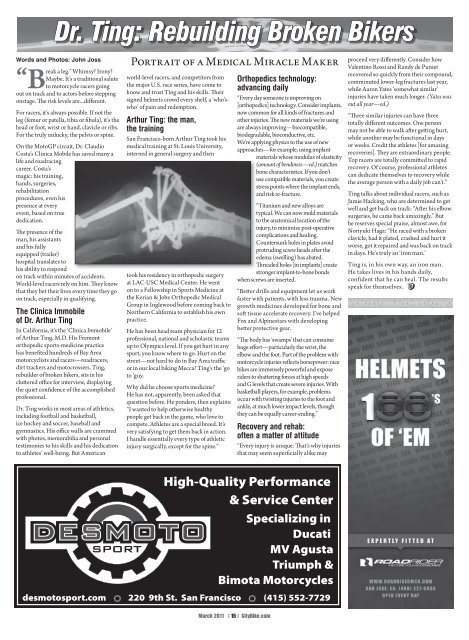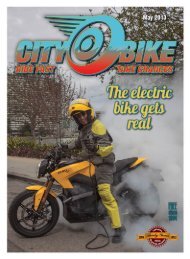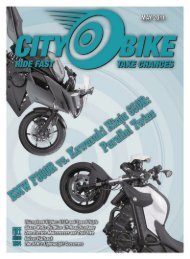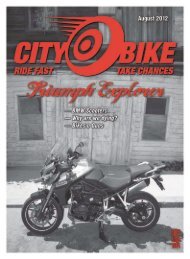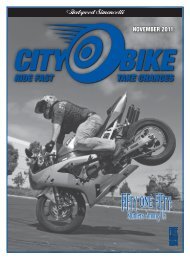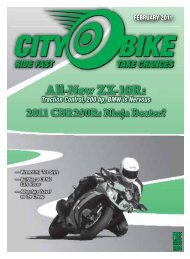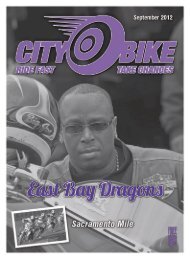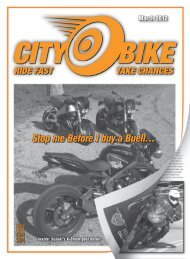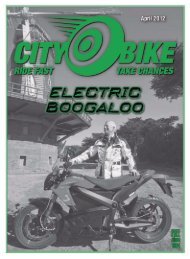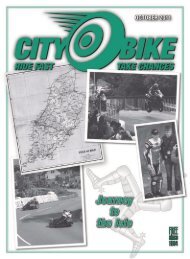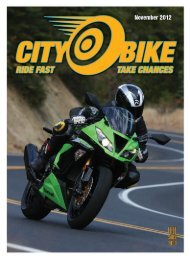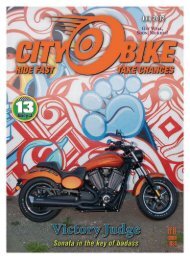Triumph Sprint GT 1050 - Level Five Graphics
Triumph Sprint GT 1050 - Level Five Graphics
Triumph Sprint GT 1050 - Level Five Graphics
Create successful ePaper yourself
Turn your PDF publications into a flip-book with our unique Google optimized e-Paper software.
Dr. Ting: Rebuilding Broken BikersWords and Photos: John Jossa leg.” Whimsy? Irony?Maybe. It’s a traditional salute“Breakto motorcycle racers goingout on track and to actors before steppingonstage. The risk levels are...different.For racers, it’s always possible. If not theleg (femur or patella, tibia or fibula), it’s thehead or foot, wrist or hand, clavicle or ribs.For the truly unlucky, the pelvis or spine.On the MotoGP circuit, Dr. ClaudioCosta’s Clinica Mobile has saved many alife and roadracingcareer. Costa’smagic: his training,hands, surgeries,rehabilitationprocedures, even hispresence at everyevent, based on truededication.The presence of theman, his assistantsand his fullyequipped (trailer)hospital translates tohis ability to respondon track within minutes of accidents.World-level racers rely on him. They knowthat they bet their lives every time they goon track, especially in qualifying.The Clinica Immobileof Dr. Arthur TingIn California, it’s the ‘Clinica Immobile’of Arthur Ting, M.D. His Fremontorthopedic sports-medicine practicehas benefited hundreds of Bay Areamotorcyclists and racers—roadracers,dirt trackers and motocrossers. Ting,rebuilder of broken bikers, sits in hiscluttered office for interview, displayingthe quiet confidence of the accomplishedprofessional.Dr. Ting works in most areas of athletics,including football and basketball,ice hockey and soccer, baseball andgymnastics. His office walls are crammedwith photos, memorabilia and personaltestimonies to his skills and his dedicationto athletes’ well-being. But AmericanPortrait of a Medical Miracle Makerworld-level racers, and competitors fromthe major U.S. race series, have come toknow and trust Ting and his skills. Theirsigned helmets crowd every shelf, a ‘who’swho’of pain and redemption.Arthur Ting: the man,the trainingSan Francisco-born Arthur Ting took hismedical training at St. Louis University,interned in general surgery and thentook his residency in orthopedic surgeryat LAC-USC Medical Center. He wenton to a Fellowship in Sports Medicine atthe Kerian & Jobe Orthopedic MedicalGroup in Inglewood before coming back toNorthern California to establish his ownpractice.He has been head team physician for 12professional, national and scholastic teamsup to Olympics level. If you get hurt in anysport, you know where to go. Hurt on thestreet—not hard to do in Bay Area trafficor in our local biking Mecca? Ting’s the ‘goto ‘guy.Why did he choose sports medicine?He has not, apparently, been asked thatquestion before. He ponders, then explains:“I wanted to help otherwise healthypeople get back in the game, who love tocompete. Athletes are a special breed. It’svery satisfying to get them back in action.I handle essentially every type of athleticinjury surgically, except for the spine.”Orthopedics technology:advancing daily“Every day someone is improving on[orthopedics] technology. Consider implants,now common for all kinds of fractures andother injuries. The new materials we’re usingare always improving—biocompatible,biodegradable, bioconductive, etc.We’re applying physics to the use of newapproaches—for example, using implantmaterials whose modulus of elasticity(amount of bendiness—ed.) matchesbone characteristics. If you don’tuse compatible materials, you createstress points where the implant ends,and risk re-fracture.“Titanium and new alloys aretypical. We can now mold materialsto the anatomical location of theinjury, to minimize post-operativecomplications and healing.Countersunk holes in plates avoidprotruding screw heads after theedema (swelling) has abated.Threaded holes [in implants] createstronger implant-to-bone bondswhen screws are inserted.“Better drills and equipment let us workfaster with patients, with less trauma. Newgrowth medicines developed for bone andsoft tissue accelerate recovery. I’ve helpedFox and Alpinestars with developingbetter protective gear.“The body has ‘swamps’ that can consumehuge effort—particularly the wrist, theelbow and the foot. Part of the problem withmotorcycle injuries reflects horsepower: racebikes are immensely powerful and exposeriders to shattering forces at high speedsand G levels that create severe injuries. Withbasketball players, for example, problemsoccur with twisting injuries to the foot andankle, at much lower impact levels, thoughthey can be equally career-ending.”Recovery and rehab:often a matter of attitude“Every injury is unique. That’s why injuriesthat may seem superficially alike mayproceed very differently. Consider howValentino Rossi and Randy de Punietrecovered so quickly from their compound,comminuted lower-leg fractures last year,while Aaron Yates ‘somewhat similar’injuries have taken much longer. (Yates wasout all year—ed.)“Three similar injuries can have threetotally different outcomes. One personmay not be able to walk after getting hurt,while another may be functional in daysor weeks. Credit the athletes [for amazingrecoveries]. They are extraordinary people.Top racers are totally committed to rapidrecovery. Of course, professional athletescan dedicate themselves to recovery whilethe average person with a daily job can’t.”Ting talks about individual racers, such asJamie Hacking, who are determined to getwell and get back on track: “After his elbowsurgeries, he came back amazingly.” Buthe reserves special praise, almost awe, forNoriyuki Haga: “He raced with a brokenclavicle, had it plated, crashed and hurt itworse, got it repaired and was back on trackin days. He’s truly an ‘iron man.’Ting is, in his own way, an iron man.He takes lives in his hands daily,confident that he can heal. The resultsspeak for themselves.March 2011 | 15 | CityBike.com


